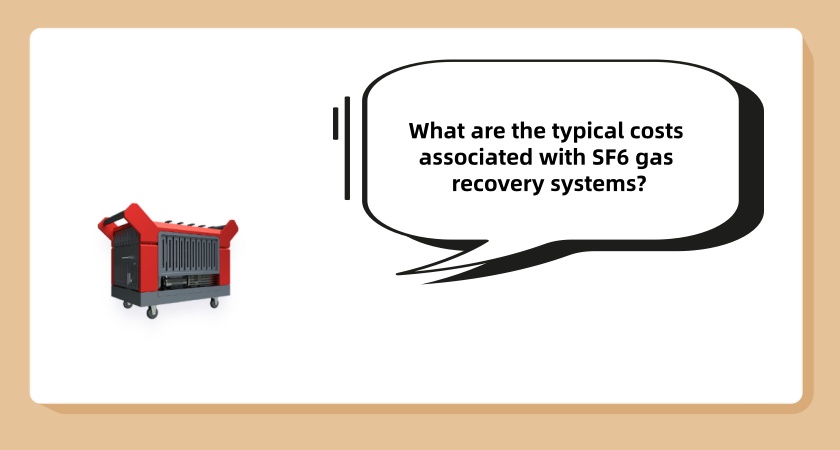The cost of SF6 gas recovery systems varies drastically—from $10,000 to over $150,000 total—depending on capacity, features, brand, and operational needs. For businesses managing high-voltage equipment, understanding these cost components is critical to budgeting effectively while ensuring regulatory compliance and long-term efficiency. This guide breaks down every expense, key influencing factors, and cost-saving tips to help you make informed decisions.
1. Initial Purchase Cost (Largest Upfront Expense)
This accounts for 50-70% of total costs, with prices tied to SF6 gas recovery system capabilities:
Core Equipment: Basic portable units (10-50 kg/h recovery capacity, 95% efficiency) start at $5,000-$15,000. Mid-range systems (50-100 kg/h, 98% efficiency, integrated purification) cost $15,000-$35,000. High-end stationary systems (100-200 kg/h, 99.5% efficiency, IoT monitoring) range from $35,000-$80,000.
Add-Ons: Purification modules ($2,000-$8,000), drying systems ($1,500-$5,000), and smart monitoring tools ($3,000-$12,000) boost costs but enhance compliance and reuse rates.
Brand Impact: Reputable manufacturers (DILO, ABB) charge 15-30% more than generic brands, but offer better durability and warranty coverage (2-5 years vs. 1 year).
2. Installation Costs ($1,000-$15,000)
Labor: Professional installation ranges from $800-$5,000, depending on complexity (portable units take 1-2 days; stationary systems 3-5 days).
Infrastructure Modifications: If your facility lacks compatible power (380V/480V) or storage space, upgrades like wiring or tank foundations add $200-$10,000.
Location Premium: Urban areas or remote sites (e.g., offshore wind farms) may incur 20-40% higher labor and transport fees.
3. Operating Costs ($1,500-$8,000/Year)
Maintenance: Routine servicing (filter replacement, calibration) costs $500-$2,000/year. Major overhauls (every 3-5 years) add $1,000-$3,000.
Training: Initial operator training ($300-$1,500) and annual refreshers ($200-$800) ensure safe use and compliance.
Consumables: Filters, desiccants, and purification media cost $300-$1,200/year, depending on usage frequency.
Energy: Annual energy costs range from $200-$1,000, with stationary systems consuming 5-15 kW/h during operation.
4. Compliance & Monitoring Costs ($1,000-$12,000)
Leak Detection Systems: Basic ultrasonic detectors ($1,000-$3,000) vs. advanced laser-based models ($5,000-$10,000) with 0.1 ppm sensitivity (required for EU F-Gas compliance).
Regulatory Expenses: Audit fees ($500-$2,000/year) and potential upgrades to meet evolving standards (e.g., 2024 EU F-Gas requirements) add $500-$3,000 every 3-5 years.
5. End-of-Life Costs ($1,500-$8,000)
Equipment Disposal: Certified disposal of units and components costs $800-$3,000, plus $700-$5,000 for safe residual SF6 gas handling (per EPA and IEC 60480 standards).
Key Cost-Saving Tips
Choose Modular Systems: Start with core features and add upgrades (e.g., IoT monitoring) as needs grow, avoiding over-investment upfront.
Prioritize Energy Efficiency: Energy-star rated systems cut annual energy costs by 20-30%.
Negotiate Maintenance Packages: Bundled service contracts with manufacturers reduce annual maintenance costs by 15-25%.
Reuse vs. Replace: High-purity recovery (98%+) reduces new SF6 purchases by 40%, offsetting upfront costs in 2-3 years.
Total Cost Summary
Basic Setup (Portable, 10-50 kg/h): $12,500-$30,000 (initial + 5-year operating costs).
Mid-Range Setup (50-100 kg/h, integrated features): $35,000-$85,000 (initial + 5-year operating costs).
High-End Setup (100-200 kg/h, stationary): $90,000-$180,000 (initial + 5-year operating costs).
Investing in a quality SF6 recovery system balances short-term costs with long-term savings from reduced gas purchases and avoided fines. By aligning your budget with actual capacity and compliance needs, you can optimize ROI while meeting environmental obligations.


Leave A Message
Your email address will not be published. Required fields are marked *